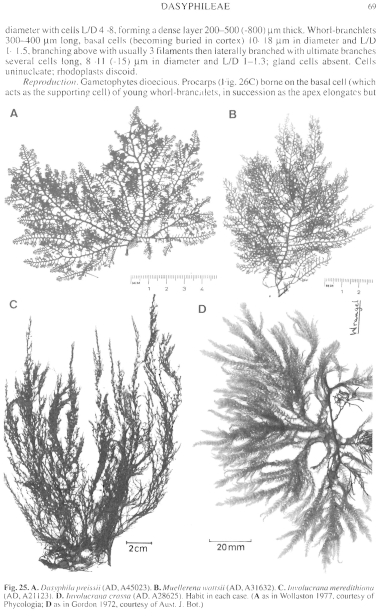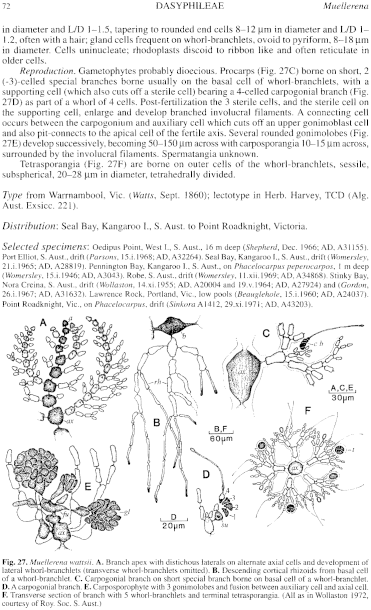|
|
|
|
|
|||||||||||
|
Electronic Flora of South Australia Species Fact Sheet
Phylum Rhodophyta – Order Ceramiales – Family Ceramiaceae – Tribe Dasyphileae
Selected citations: De Toni 1903: 1388. Kylin 1956: 397. Lucas 1909: 50. Lucas & Perrin 1947: 344. Mazza 1911: No. 397. Wollaston 1972: 119, figs 1–20; 1977a: 450.
Synonym
Crouania wattsii Harvey 1863, pl. 291, synop.: xlix. J. Agardh 1876: 86. Sonder 1881: 12. Tisdall 1898: 503.
Thallus (Fig. 25B) mid to dark red-brown, 3–13 cm high, consistently distichously and alternately branched throughout for 4 (–5) orders, axes and branches terete. Holdfast discoid, rhizoidal, 1–2 mm across; epiphytic on larger algae or epilithic(?). Structure. Apical cells dividing transversely, cutting off from subapical cells whorls of 5 whorl-branchlets (Fig. 27F) in alternating sequence, with lateral branches (curved when young) replacing one of the whorl-branchlets and arising alternately 2 axial cells apart (Fig. 27A). Axial cells enlarging from 15–30 µm in diameter and L/D 1–1.3 just below apices to 100–200 µm in diameter and L/D 1–1.5 in the lower thallus, becoming densely corticated by descending rhizoids (Fig. 27B) from the basal cells of whorl-branchlets, with short outward filaments. Whorl-branchlets (Fig. 27F) 90–140 µm long, 3–5 times di- or trichotomous, basal cells 25–40 µm in diameter and L/D 1–1.5, tapering to rounded end cells 8–12 µm in diameter and L/D 1–1.2, often with a hair; gland cells frequent on whorl-branchlets, ovoid to pyriform, 8–18 µm in diameter. Cells uninucleate; rhodoplasts discoid to ribbon like and often reticulate in older cells.
Reproduction: Gametophytes probably dioecious. Procarps (Fig. 27C) borne on short, 2 (–3)-celled special branches borne usually on the basal cell of whorl-branchlets, with a supporting cell (which also cuts off a sterile cell) bearing a 4-celled carpogonial branch (Fig. 27D) as part of a whorl of 4 cells. Post-fertilization the 3 sterile cells, and the sterile cell on the supporting cell, enlarge and develop branched involucral filaments. A connecting cell occurs between the carpogonium and auxiliary cell which cuts off an upper gonimoblast cell and also pit-connects to the apical cell of the fertile axis. Several rounded gonimolobes (Fig. 27E) develop successively, becoming 50–150 µm across with carposporangia 10–15 µm across, surrounded by the involucral filaments. Spermatangia unknown.
Tetrasporangia (Fig. 27F) are borne on outer cells of the whorl-branchlets, sessile, subspherical, 20–28 µm in diameter, tetrahedrally divided.
Type from Warrnambool, Vic. (Watts, Sept. 1860); lectotype in Herb. Harvey, TCD (Alg. Aust. Exsicc. 221).
Selected specimens: Oedipus Point, West 1., S. Aust., 16 m deep (Shepherd, Dec. 1966; AD, A31155). Port Elliot, S. Aust., drift (Parsons, 15.i.1968; AD, A32264). Seal Bay, Kangaroo I., S. Aust., drift (Womersley, 21.i.1965; AD, A28819). Pennington Bay, Kangaroo I., S. Aust., on Phacelocarpus peperocarpos, 1 m deep (Womersley, 15.i.1946; AD, A3043). Robe, S. Aust., drift (Womersley, 11.xii.1969; AD, A34868). Stinky Bay, Nora Creina, S. Aust., drift (Wollaston, 14.xi.1955; AD, A20004 and 19.v.1964; AD, A27924) and (Gordon, 26.i.1967; AD, A31632). Lawrence Rock, Portland, Vic., low pools (Beauglehole, 15.i.1960; AD, A24037). Point Roadknight, Vic., on Phacelocarpus, drift (Sinkora A1412, 29.xi.1971; AD, A43203).
Distribution: Seal Bay, Kangaroo I., S. Aust. to Point Roadknight, Victoria.
References:
AGARDH, J.G. (1876). Species Genera et Ordines Algarum. Vol. 3, Part 1- Epicrisis systematic Floridearum, pp. i-vii, 1–724. (Weigel: Leipzig.)
DE TONI, G.B. (1903). Sylloge Algarum omnium hucusque Cognitarum. Vol. 4. Florideae. Sect. 3, pp. 775–1521 + 1523–1525. (Padua.)
HARVEY, W.H. (1863). Phycologia Australica. Vol. 5, Plates 241–300, synop., pp. i-lxxiii. (Reeve: London.)
KYLIN, H. (1956). Die Gattungen der Rhodophyceen. (Gleerups: Lund.)
LUCAS, A.H.S. & PERRIN, F. (1947). The Seaweeds of South Australia. Part 2. The Red Seaweeds. (Govt Printer: Adelaide.)
LUCAS, A.H.S. (1909). Revised list of the Fucoideae and Florideae of Australia. Proc. Linn. Soc. N.S.W. 34, 9–60.
MAZZA, A. (1911). Saggio di Algologia Oceanica. Nuova Notarisia 22, Nos. 369–393.
SCHMITZ, F. & HAUPTFLEISCH, P. (1897). Ceramiaceae. In Engler, A. & Prantl, K., Die natarlichen Pflanzenfamilien, Vol. 1, Part 2, pp. 481–504. (Leipzig.)
SONDER, O.W. (1881). In Mueller, F., Fragmenta Phytographiae Australiae. Supplementum ad volumen undecinum: Algae Australianae hactenus cognitae, pp. 1–42, 105–107. (Melbourne.)
TISDALL, H.T. (1898). The algae of Victoria. Rep. 7th Meet. Aust. Ass. Adv. Sci., Sydney, 1898, pp. 493–516.
WOLLASTON, E.M. (1972). The morphology and relationships of Muellerena wattsii (Harvey) Schmitz (Ceramiaceae, Rhodophyta). Trans. R. Soc. S. Aust. 96, 119–124.
WOLLASTON, E.M.(1977a). Morphology and life history of Dasyphila preissii Sonder, with notes on the taxonomic position of Muellerena wattsii (Harvey) Schmitz (Rhodophyta, Ceramiaceae). Phycologia 16, 443–450.
The Marine Benthic Flora of Southern Australia Part IIIC complete list of references.
Publication:
Womersley, H.B.S. (24 December, 1998)
The Marine Benthic Flora of Southern Australia
Rhodophyta. Part IIIC. Ceramiales – Ceramiaceae, Dasyaceae
©State Herbarium of South Australia, Government of South Australia
Illustrations in Womersley Part IIIA, 1998: FIGS 25B, 27.

Figure 25 enlarge
Fig. 25. A. Dasyphila preissii (AD, A45023). B. Muellerena wattsii (AD, A31632). C. Involucrana meredithiana (AD, A21123). D. Involucrana crassa (AD, A28625). Habit in each case. (A as in Wollaston 1977, courtesy of Phycologia; D as in Gordon 1972, courtesy of Aust. J. Bot.)

Figure 27 enlarge
Fig. 27. Muellerena wattsii. A. Branch apex with distichous laterals on alternate axial cells and development of lateral whorl-branchlets (transverse whorl-branchlets omitted). B. Descending cortical rhizoids from basal cell of a whorl-branchlet. C. Carpogonial branch on short special branch borne on basal cell of a whorl-branchlet. D. A carpogonial branch. E. Carposporophyte with 3 gonimolobes and fusion between auxiliary cell and axial cell. F. Transverse section of branch with 5 whorl-branchlets and terminal tetrasporangia. (All as in Wollaston 1972, courtesy of Roy. Soc. S. Aust.)

|
Email Contact: State Herbarium of South Australia |

|